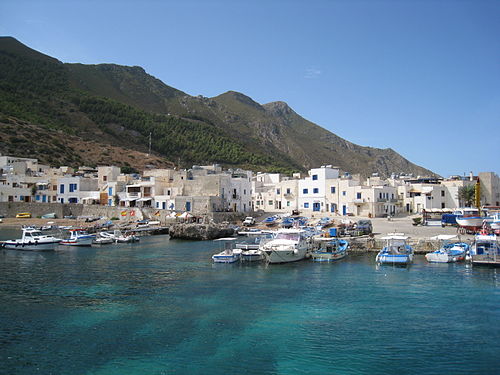Marettimo
Marettimo is the wildest and most remote of the Aegadian Islands, a rugged limestone outcrop rising steeply from the sea some 40 km west of Trapani. As part of the Egadi Islands Marine Protected Area, it offers crystalline waters, dramatic hiking trails, and a blissfully car-free village where time seems to stand still.

Understand
[edit]Known as Hiera (“sacred”) in antiquity, Marettimo has long inspired myth, rumour, and reverence. Some associate it with Homer’s Ithaca, while the Romans built lookout stations here during the Punic Wars. Today, Marettimo remains sparsely populated — with just a few hundred residents — and deeply traditional.
Fishing is still a mainstay of island life, alongside small-scale tourism and nature preservation. The cliffs, caves, and scrub-covered peaks are home to rare plants, birds, and animals found nowhere else, thanks to the island’s long isolation from the mainland. Hiking paths crisscross the hills, leading to historic towers, remote chapels, and panoramic lookouts, while boats explore sea caves and offshore islets. With no roads or cars beyond the port, Marettimo is ideal for unplugging and exploring at a gentler pace.
Get in
[edit]Marettimo 1 port is the most distant of the Aegadian Islands, reached only by boat from Trapani. High-speed hydrofoils take around 1 hour, while ferries are slower but scenic. Service is year-round, though sailings are less frequent in winter, and seas can be rough. Tickets can be purchased online or at the Trapani port. In high season, especially on weekends and evenings, it’s best to arrive early as boats often fill up.
- Liberty Lines – hydrofoils from Trapani (year-round); Marsala is not served.
- Siremar – occasional ferries from Trapani (foot passengers only on Marettimo).
Get around
[edit]Marettimo is completely roadless outside the port, and no cars or scooters are allowed. Getting around means hiking, swimming, or taking a boat — all ideal ways to explore this rugged and pristine island.
- On Foot & Hiking: Old mule tracks and marked trails wind across the island, leading to ancient churches, watchtowers, and peaks with sweeping views. Trails vary from easy shoreline walks to steep mountain hikes — bring good shoes, water, and a map.
- Boat & Cave Tours: Local skippers run boat trips around the island, often stopping to swim in sea caves or snorkel above underwater rock shelves. Marettimo’s coast is famously indented and dotted with grottos, many of which are accessible only by sea.
See
[edit]
Marettimo’s sights are shaped by nature, history, and isolation. From ruined chapels and mountaintop castles to wave-battered lighthouses and ancient monasteries, each site tells a story of seafarers, hermits, monks, and invaders. These places are often reached on foot along rugged trails, so wear good shoes and bring water — the views, solitude, and sense of discovery are well worth the effort.
- 1 Castello di Punta Troia (Punta Troia Castle). Perched on a rocky promontory north of the village, this medieval fortress began life as a Saracen watchtower (9th c.), was rebuilt by the Normans around 1140, and later modified under Spanish rule. The cistern below became a notorious prison ("the Pit") until the 19th c. Today it houses a small prison museum and the Egadi Marine Protected Area’s monk‑seal observatory. Accessible via a steep footpath or by boat, it offers dramatic views across the Egadi and insight into centuries of island defence.
- 2 Chiesetta Bizantina (Byzantine Church). A serene archaeological site featuring the remains of Roman-period buildings and a small Byzantine-era church, built by Basilian monks in the 11th–12th centuries using ancient Roman walls. The church has a single nave divided into three bays and an eastern apse. Accessible via a 40-minute uphill trek from the port, the site offers historical insight and sweeping views of the Egadi Islands.
- 3 Faro di Punta Libeccio (Punta Libeccio Lighthouse). An atmospheric mid‑19th‑century lighthouse perched on the rocky western tip of Marettimo. It marks the boundary of the Marine Protected Area and is encircled by dramatic cliffs and waves. Reached via a challenging 3‑hour round‑trip hike from the village—it’s best at sunset, when seabirds circle and the vast ocean stretches silent below.
Do
[edit]
Marettimo is all about sea, stone, and solitude. With no cars and few crowds, the island rewards those who explore on foot or by boat. Hike to remote coves, snorkel over seagrass meadows, or venture into sea caves lit by shifting sunlight. Whether you're seeking quiet beaches, marine life, or dramatic coastal landscapes, Marettimo offers wild beauty at every turn.
- 1 Cala Bianca (White Cove). Perhaps Marettimo’s most famous beach, Cala Bianca is a striking pebble-and-sand inlet tucked beneath towering cliffs at the island’s northwest. Its intense turquoise waters, crystal-clear visibility, and abundant marine life make it a paradise for swimming and snorkelling. Access is via a challenging coastal path or by boat — a tough hike, but many say the colour of the water is worth every step.
- 2 Punta Libeccio & Cala Nera (Sbarcatoio di Punta Libeccio). A wild, rocky cove just below the Punta Libeccio lighthouse—called Sbarcatoio locally—with sheer cliffs and deep, clear water. The trail down is steep and tricky; not recommended for children or the unsteady. Snorkelling reveals vibrant marine life. Many prefer to visit by boat, especially on calm days.
- 3 Grotta del Cammello (Cave of the Camel). A dramatic sea cave named for a camel‑shaped rock at the entrance. You'll need to swim or boat in—small tour boats usually include it on circumnavigation trips. Sunlight streams through a ceiling opening, illuminating the water with eerie turquoise tones. Around midday is best for light. The cave is natural habitat for monk seals, occasionally spotted resting inside. No entrance fee, but access depends on sea conditions.
- 4 Grotta della Bombarda (Bombard Cave). Named for its booming bombard sound when waves hit its entrance, this cave features a tall stalagmite shaped like a papal mitre. Reached by boat, it’s a dramatic stop on island‑wide sea excursions, especially when swells make the cavern “roar.”
- 5 Grotta del Presepe (Crib Cave). A large sea cave named for its stalactites and stalagmites that resemble a nativity scene. Best visited in the late afternoon when light filters in to dramatically highlight the formations. Access is by boat and often combined with snorkelling stops — common on full‑island cave tours.
- 6 Grotta della Pipa (Pipe Cave). A towering 20 m–high cave that stretches inland for about 100 m and ends in a rare freshwater pool. Ancient pottery shards and oil‑lamp fragments indicate long‑ago use by islanders. Accessible by boat or via a coastal trek.
- 7 Spiaggia di Cala Sarde (Cala Sarde Beach). A sheltered pebble beach nestled in a rocky inlet on Marettimo’s south coast. Its turquoise, calm waters make it perfect for swimming or snorkelling—ideal after a coastal trek. Accessible by foot via a 30‑minute trail from the port or by boat when seas are calm. No facilities, so bring water, shade, and essentials.
Eat
[edit]
Marettimo has only a handful of restaurants and bars, most clustered near the port. Menus lean heavily on local seafood — swordfish, tuna, octopus, and lobster — often served simply with pasta or grilled. Expect seasonal, home-style Sicilian cooking, and don’t be surprised if the menu changes daily based on the morning’s catch. In high season, it’s wise to book ahead for dinner.
Drink
[edit]There’s no dedicated nightlife on Marettimo, but a few harbour-side bars serve wine, spritzes, and cold beer. Evenings often find visitors and locals chatting under starry skies with a drink in hand. Some places also offer simple snacks or gelato. Expect relaxed service and friendly, unhurried atmosphere.
Buy
[edit]Shops are limited—there’s a small alimentari stocking basic groceries (bread, cheese, pasta, drinks), a seasonal bakery, and a few souvenir stalls near the port. Most produce and tourist shops close by early evening. If staying longer, it’s wise to stock up on essentials upon arrival—or bring items from Trapani or Favignana.
Sleep
[edit]
Accommodation on Marettimo is limited but atmospheric, mostly consisting of simple guesthouses, self-catering apartments, and the occasional boutique stay. Options are concentrated in the village near the port, with stunning views, quiet surroundings, and easy access to the island’s trails and boat tours. Advance booking is essential in summer, when the island’s small capacity fills quickly.
- Hiera Marettimo (Hiera Guesthouse). A beautifully restored two-bedroom former fisherman’s house perched above Marettimo’s harbour, offering uninterrupted views of the sea. Decorated with maritime antiques and handmade curios, it blends rustic character with comfort. The rooftop terrace is a highlight — perfect for stargazing or aperitivi at sunset. Ideal for travellers looking for privacy, charm, and a direct connection to island life.
Stay safe
[edit]Marettimo is a very safe and peaceful island, with virtually no crime. That said, the terrain can be rugged and remote, so caution is needed when hiking — trails can be steep, exposed, and poorly marked in places. Wear sturdy footwear, carry plenty of water, and avoid hiking alone, especially in hot weather.
If swimming or boating, check local conditions first. Sea caves and exposed coves may be unsafe in rough seas or strong winds. There are no lifeguards and limited mobile coverage in remote areas, so take care and inform someone if heading off the beaten path.
Go next
[edit]The Aegadian Islands are all connected by ferry and hydrofoil, making it easy to hop between them.
- Favignana – The largest and liveliest island, with bicycle paths, sandy beaches, and the dramatic ex‑tuna cannery museum. A good base for island-hopping.
- Levanzo – The smallest and most tranquil island, known for its crystal-clear waters, prehistoric cave art, and peaceful harbour village.
Daily boats also link the islands with Trapani on the Sicilian mainland — the main transport hub for the Egadis — and seasonally with Marsala.


 Français
Français Italiano
Italiano





